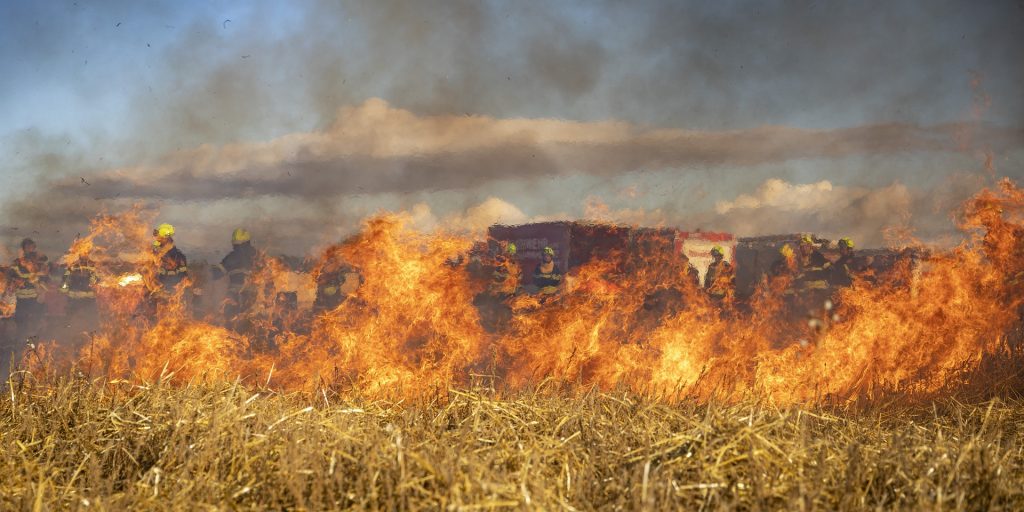As extreme weather increases, cities brace for climate-related migration
Over the last decade, harrowing videos of residents fleeing down smokey roadways, hedged on either side by flames, have captivated the national spotlight. They’ve given a sense of urgency to the fight against climate changed, and pushed elected officials at the national level to take policy action. In 2020, for example, 1.7 million Americans were displaced by natural disasters.
But while these dramatic escapes might come and go with fire season, a slower, steadier exit is taking place in cities across the nation—climate-related migration.
“Climate change is no longer just a problem for future generations—it is happening here and now. With each storm, with each wildfire, drought, and dangerous heat wave, America’s towns and villages are being impacted,” said Clarence Anthony, director of the National League of Cities (NLC) in the introduction to a webinar covering a report released by the advocacy organization Thursday titled “The Next American Migration: What Cities Should Know About Climate Change and Populations on the Move.” In coming years, “These population shifts will become more difficult to ignore and will present our communities with great challenges–and in some cases, opportunity.”
The report broadly covers climate shifts across the United States—like extreme rainfall in the northeast and wildfires in the west—and the impact it has had and will have on societies. It also includes case studies highlighting challenges faced by cities and solutions communities have implemented, anticipating population changes and new norms.
Mayor Keith James, of West Palm Beach, Fla., said local leaders there are seeing “increasingly hot temperatures, and we expect that to continue.” Along with shifting rain patterns and wetter winters, there’s also been an “increase in the number of tropical storms and the dreaded ‘h’ word–hurricanes.”
In response, the city is attempting to reduce its carbon footprint, with a goal of net-zero by 2050, through policy changes like one-day solar permitting.
“We have so, so much more work to do,” James said, stressing that, in the global fight against climate change, it’s vital for municipal leaders to “know what your situation is so you can start to make plans moving forward.”
To that end, municipal levers like building codes can be modified to increase community resilience, and economic policy decisions can make cities attractive “safe havens” for those fleeing disaster-prone areas.
Orlando, Fla., is one of those areas. Officials there project a population increase due to climate-related migration of between 400,000 and 500,000 people in coming decades, according to Chris Castro, director of the city’s Office of Sustainability & Resilience, citing a few recent studies.
“Although we’re a coastal city, we’re inland,” Castro said, noting administrators are actively considering “What it means to prepare for mass-migration.”
It’s not just coastal cities confronting this reality. Other communities listed as examples in the report include Flagstaff, Ariz. and Ann Arbor, Mich. The report notes that some areas will implement controlled retreats from particularly vulnerable to climate change.
In Colorado, the “aridification of the west” is having a chain reaction, according to Jeni Arndt, mayor of Fort Collins, citing a general increase in wildfires in the state.
“On a cheery note, after the fires come the floods. It washes down the berm,” she said. “We’ve seen the (Cache la) Poudre River run absolutely black. That impacts our water supply.”
It’s affecting every season and, as a byproduct, the area’s population density and regional norms: “Our snowpack is melting sooner. Even after winters where we see a relatively normal winter, it melts faster. It’s a chain event driven by the aspects of climate,” she continued.
Speaking from personal experience, Arndt said she’s seen a glimpse of what future climate-related migration might look like.
“None of my kids want to live here because of the smoke in August. They don’t want to be inside for a month—it’s thick, black smoke,” Arndt said. The report cites that one in seven Americans experienced dangerous levels of air quality from wildfire smoke in 2020.
And while seasonal displacement might only temporarily impact populations, with many residents these days returning after the danger has passed, “Eventually, cities may face out-migration as residents grow weary of repetitive disasters,” the report says. “Other factors such as city size, staff capacity, existing stressors such as transportation gridlock or a housing shortage can influence these movements as well as the community’s ability to absorb and adapt to these new conditions.”
Beyond the health aspect, some states are facing serious energy concerns.
As Lake Powell recedes, depressed by drought-conditions that show now signs of ebbing, “We’re losing hydropower,” Arndt said, referring to climate change as “a threat multiplier.”
Kelly Lelani Main, executive director and co-founder of Buy-In Community Planning, Inc., and the report’s co-author along with Anna Marandi, of the National League of Cities, noted there’s an equity aspect to the response communities must take: “Climate change is not going to affect every city and every community equally,” she said. Because of this, local administrators should focus their efforts on protecting all people through social initiatives and by fostering equitable systems.
Populations particularly at risk during climate-related events, as noted in the report, include children, the elderly, low income households and renters, people of color, rural and immigrant communities, women, particularly mothers and pregnant women, and undocumented residents, among others.
In preparing for climate-related migration, administrators face a difficult balance. For every benefit, there’s a cost, according to Arndt. For example, building codes designed to harden structures against a changing climate drive up housing prices, she said, describing her mayoral role as “walking this fine line between some of these trade-offs.”
In this, with the passage of the American Rescue Plan Act and the Bipartisan Infrastructure Law, communities have a unique chance to prepare for climate-related migration.
“Local leaders have a critical opportunity to transform their communities into more equitable places to live,” said Anthony, highlighting as a “necessity” the protection of affordable housing and investment in carbon mitigation strategies.




















